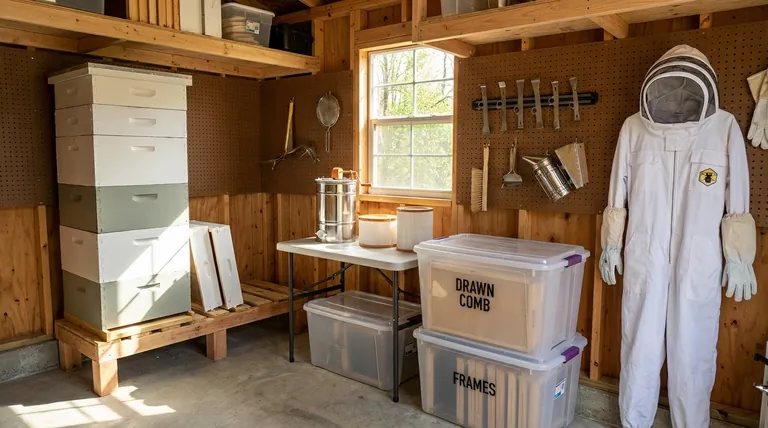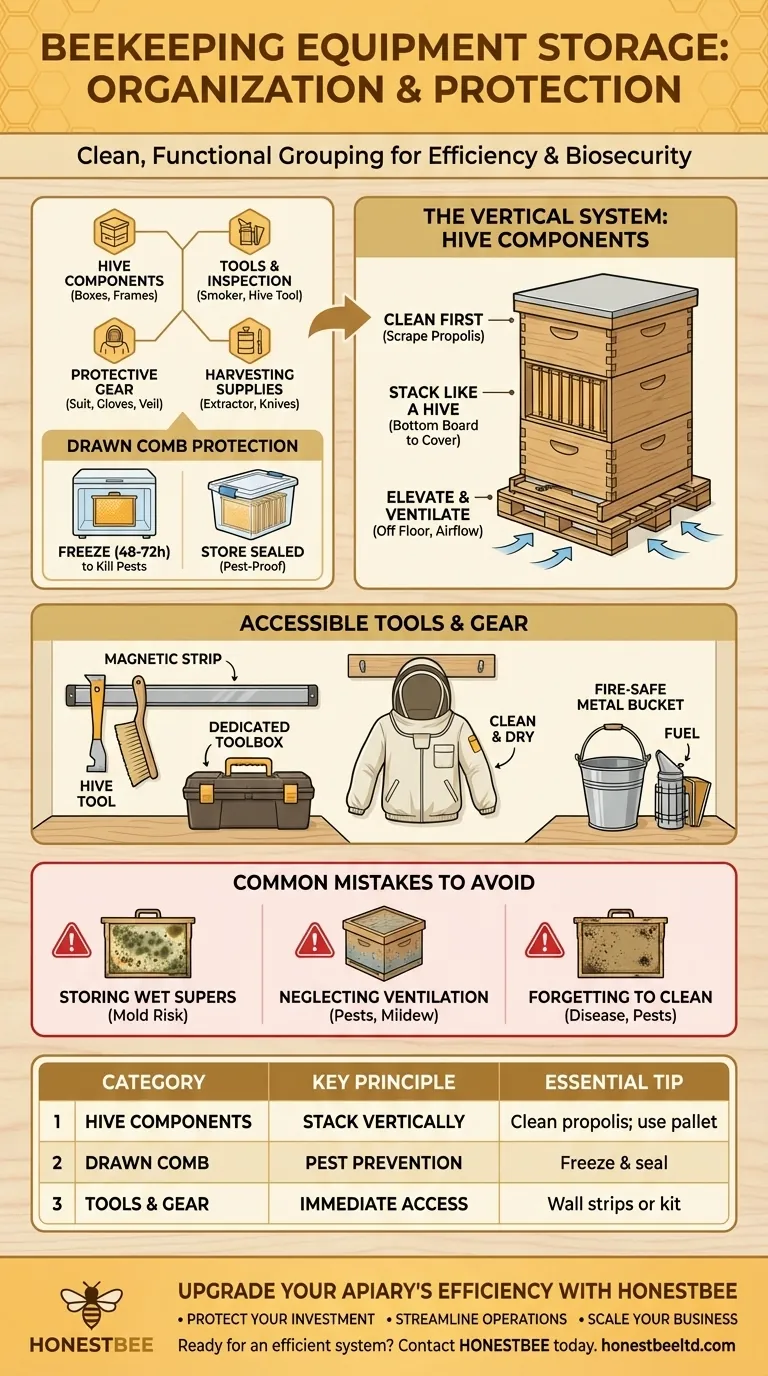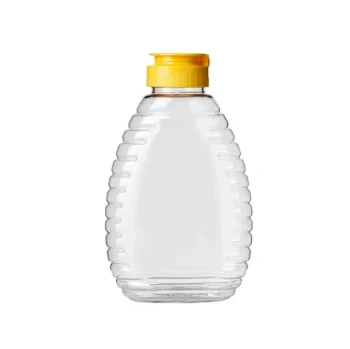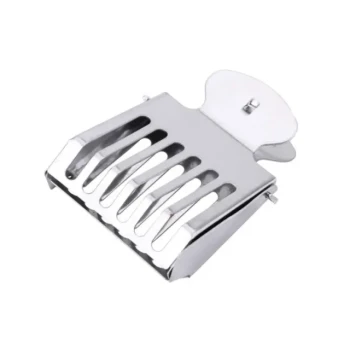The best way to organize beekeeping equipment is to first clean it thoroughly and then group it by function: hive components, tools, protective gear, and harvesting supplies. Stack hive bodies and supers vertically as they would be on a hive, ensure drawn comb is protected from pests, and designate specific, accessible locations for your most-used tools and clothing. This approach protects your investment and streamlines your workflow.
Disorganization in beekeeping leads to more than just clutter; it invites pests, spreads disease, and creates stress during critical hive inspections. The most effective storage system is built not just on tidiness, but on the principles of biosecurity, pest prevention, and immediate accessibility.

The Foundational Principle: Organize by Function
A disorganized shed or garage makes finding what you need a frustrating search. By grouping items based on how and when you use them, you create an intuitive system that saves you time and protects your gear.
Why Functional Grouping Works
Beekeeping tasks are seasonal and specific. You don't need your honey extractor during a spring swarm check. Grouping by function means you only access the equipment relevant to the task at hand, leaving the rest undisturbed and properly stored.
The Four Core Categories
Nearly all your equipment will fall into one of four groups:
- Hive Components: Boxes (supers), frames, foundation, inner/outer covers, and bottom boards.
- Tools & Inspection Gear: Your hive tool, bee brush, smoker, and fuel.
- Protective Clothing: Bee suit, veil, gloves, and boots.
- Harvesting & Processing: Extractors, uncapping knives, filters, and bottling equipment.
Storing Hive Components: The Vertical System
Hive bodies and supers make up the bulk of your equipment. Storing them correctly is crucial for longevity and biosecurity.
Stack Like a Hive for Efficiency
The most space-efficient method is to stack your boxes vertically. Place a bottom board or a queen excluder on a pallet or blocks to get the stack off the floor. This improves airflow and denies rodents an easy entrance. You can then stack supers and hive bodies on top, finishing with an outer cover.
The Critical First Step: Clean Before You Store
Never store dirty equipment. Scrape away all excess propolis and burr comb from boxes and frames before putting them away. This removes attractants for pests like wax moths and hive beetles and is a key step in preventing the spread of disease spores like American Foulbrood (AFB).
Handling Drawn Comb vs. New Foundation
New foundation and empty frames are simple to store. Keep them in their original packaging or in a clean, dry box to protect them from dust and moisture.
Drawn comb is bee-built wax on a frame. It is a valuable resource that saves your bees immense energy, but it is also highly attractive to pests. It must be protected.
Managing Pests to Protect Your Investment
Your biggest storage challenge will be protecting drawn comb from pests, primarily wax moths and rodents.
The Threat of Wax Moths
Wax moth larvae will tunnel through and destroy drawn comb, leaving behind a mess of webbing and debris. They thrive in dark, unventilated spaces.
The Threat of Rodents
Mice love to nest in stored hive boxes over winter. They will chew through comb and frames to make space, urinate on the equipment, and can render it unusable.
Key Prevention Strategies
Airflow and Light: Storing empty supers with drawn comb crisscross-style in a bright, well-ventilated area can deter wax moths. They prefer dark, stagnant conditions.
Freezing: For absolute protection, place your frames in a chest freezer for 48-72 hours. This kills wax moths and their eggs at all life stages. After freezing, store the frames in sealed, pest-proof plastic totes or large bags.
A Dedicated Place for Tools and Gear
Your day-to-day equipment needs to be clean, dry, and ready to go at a moment's notice.
Small Hand Tools
A magnetic tool strip mounted on the wall is an excellent way to keep hive tools, frame grips, and scrapers visible and accessible. Alternatively, a dedicated "inspection toolbox" can hold your essential items.
Protective Clothing
Store your bee suit, veil, and gloves together, away from other clothing. Hang the suit to allow it to air out. Washing your bee suit regularly—separate from other laundry—removes alarm pheromones and keeps it clean for the next use.
The Smoker and Fuel
Your smoker should be stored in a fire-safe location, such as on a concrete floor or inside a metal bucket. Keep your smoker fuel (pine needles, untreated burlap, wood pellets) in a dry, sealed container to prevent it from getting damp.
Understanding the Common Storage Mistakes
Even well-intentioned beekeepers can make costly errors. Avoiding these common pitfalls is critical for maintaining healthy bees and equipment.
Storing "Wet" Supers Incorrectly
"Wet" supers are frames that have been extracted but not cleaned by the bees, leaving a film of honey. Storing these improperly in a sealed container can cause the residual honey to ferment and mold, ruining the comb. Either allow bees to clean them out or ensure massive airflow during storage.
Neglecting Ventilation
Stacking boxes flat on a concrete floor or cramming them into an airtight closet is a recipe for disaster. Lack of ventilation promotes mold, mildew, and creates an ideal environment for wax moths. Always elevate your equipment off the ground.
Forgetting to Clean Equipment
Putting away equipment covered in propolis, wax, and dead bees is the most common mistake. This not only attracts pests but can also harbor disease spores that will infect a healthy colony next season. Cleanliness is the foundation of biosecurity.
Creating Your Ideal Storage System
Your perfect system will depend on your space and priorities. Use these guidelines to build a setup that works for you.
- If your primary focus is space efficiency: Embrace vertical stacking for hive bodies and use wall-mounted shelves or pegboards for tools and smaller items.
- If your primary focus is biosecurity and pest control: Make freezing your drawn comb a non-negotiable step and ensure all equipment is scraped clean before it enters the storage area.
- If your primary focus is grab-and-go readiness: Create a dedicated "apiary kit" in a sturdy tote bag or bucket that holds your veil, gloves, hive tool, and smoker fuel.
An organized storage space is a direct investment in the health of your bees and the enjoyment of your craft.
Summary Table:
| Storage Category | Key Principle | Essential Tips |
|---|---|---|
| Hive Components | Stack Vertically | Stack like a hive on a pallet for airflow; clean all propolis and wax before storing. |
| Drawn Comb | Pest Prevention | Freeze for 48-72 hours, then store in sealed, pest-proof containers. |
| Tools & Protective Gear | Immediate Accessibility | Use wall-mounted strips or a dedicated 'inspection kit' for quick access. |
| Common Mistakes to Avoid | Biosecurity First | Never store dirty equipment; ensure proper ventilation to prevent mold and pests. |
Upgrade Your Apiary's Efficiency with HONESTBEE
A disorganized storage space costs you time and risks hive health. HONESTBEE supplies commercial apiaries and beekeeping equipment distributors with the durable, high-quality storage solutions and wholesale equipment needed to build a secure, efficient system.
We help you:
- Protect Your Investment with equipment designed for longevity and biosecurity.
- Streamline Operations with organizational solutions that save valuable time during inspections and harvests.
- Scale Your Business through our wholesale-focused operations, providing the supplies you need to grow.
Ready to implement a storage system that works as hard as you do? Contact HONESTBEE today to discuss your specific needs and discover how our products can support the health of your bees and your business.
Visual Guide

Related Products
- HONESTBEE Advanced Ergonomic Stainless Steel Hive Tool for Beekeeping
- Wholesales Dadant Size Wooden Bee Hives for Beekeeping
- Yellow Plastic Bucket Pail Perch for Beekeeping
- Ventilated Adult Beekeeping Helmet Hat for Beekeepers
- Professional Galvanized Hive Strap with Secure Locking Buckle for Beekeeping
People Also Ask
- What are the features of a regular hive tool? The Essential Multi-Tool for Every Beekeeper
- How is a hive tool used for scraping and cleaning? Master Hive Maintenance for a Healthy Colony
- What is a hive tool and what are its uses? Master Your Hive Inspections with the Essential Beekeeper's Tool
- What tools are used for cleaning frames? A Beekeeper's Simple 4-Tool Guide
- Why do hive tools have a hole? Unlock the Secret to Efficient Beekeeping



















